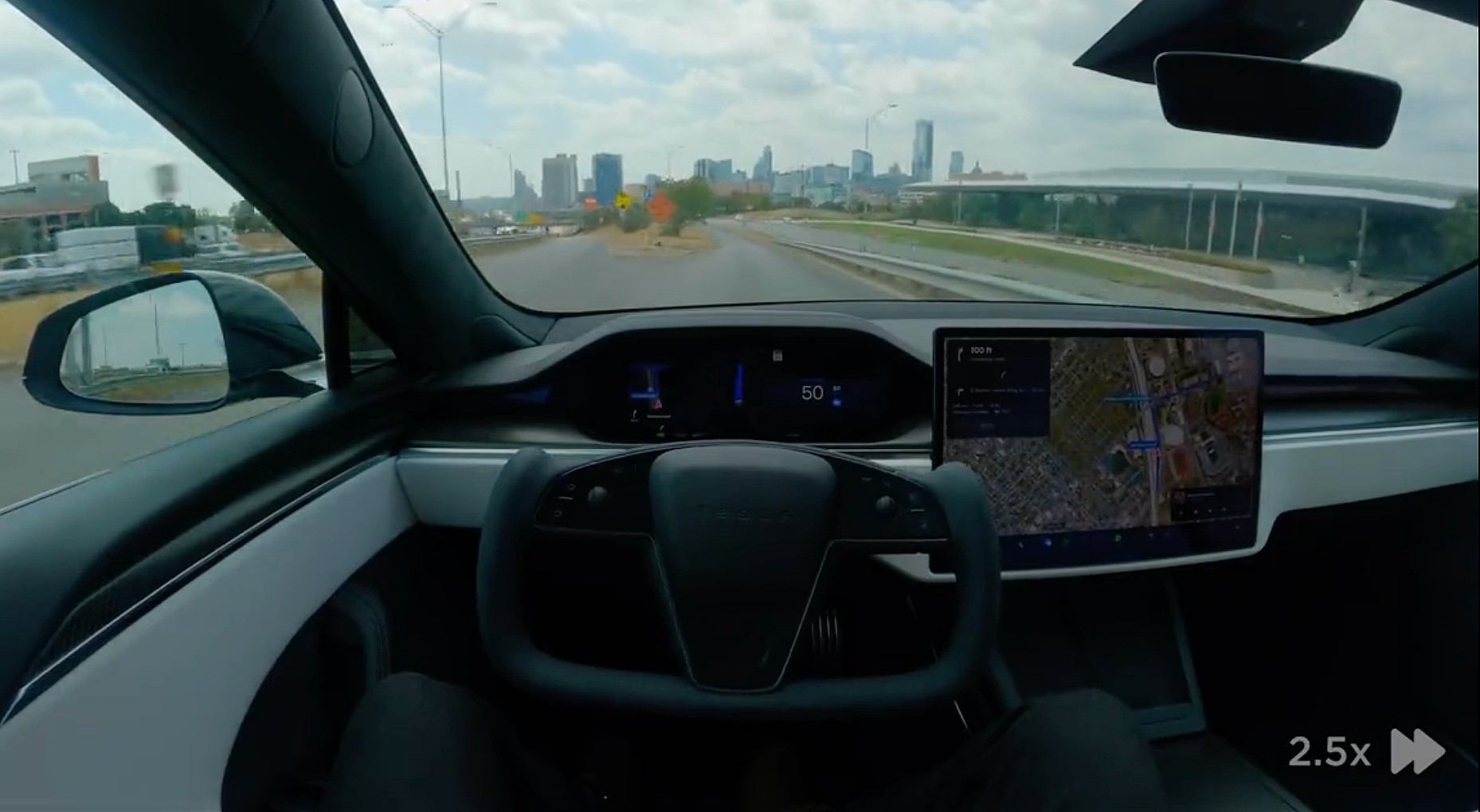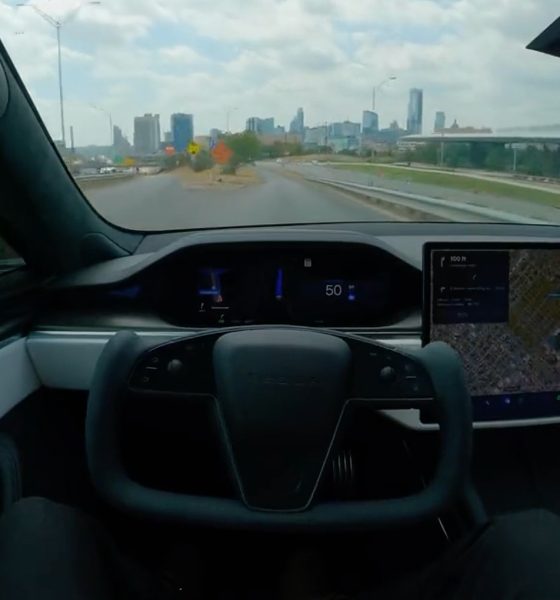Tesla has shared a video of a hands-free drive demonstration of its Full Self-Driving suite in Austin. The FSD suite is not available to customers in a hands-free nature, but Tesla disabled the requirement for a new video it shared on X, formerly known as Twitter.
Tesla shared the video to demonstrate the capabilities of Software Version 11.4.7, which is the current version of the FSD Beta program.
The automaker describes in the Tweet in put up how the Full Self-Driving suite improves through data-driven techniques that refine the capabilities through analysis of other drivers’ behavior and normal navigation habits.
Tesla Full Self-Driving capability demo in Austin
FSD capability features use vision neural networks to perceive & understand the world, just like humans do.
Via our unique fleet learning approach, we are able to collect anonymized data from our vehicles—meaning the neural… pic.twitter.com/CWAS5h0jGH
— Tesla (@Tesla) October 17, 2023
Tesla has used Neural Networks through the years to accumulate the data, which then is computed and helps refine the way FSD works, making it more accurate with every mile driven. Of course, software is far from perfect, and there are times that drivers notice steps back in the suite’s progress.
“Via our unique fleet learning approach, we are able to collect anonymized data from our vehicles—meaning the neural nets have learned from a few orders of magnitude more driving scenarios than the average human driver (including unusual & weird ones!),” Tesla wrote.
Additionally, it is interesting to see the company put out a video of a hands-free demo of the FSD suite, considering it does not support this capability with consumer vehicles.
Tesla put a disclaimer at the bottom of the video stating:
“This video shows current driving capabilities of FSD Beta, which began deploying around 8-23-2023 as software update version 11.4.7 or later. For demonstrative purposes, the cabin camera monitoring remained active but the hands-on steering wheel requirement was disabled (customers cannot disable this feature). All drivers must remain attentive and be ready to take over at any time.”
With stones consistently thrown in the direction of the Full Self-Driving program, Tesla’s new video shows the capabilities of a company vehicle, although what is displayed in the clip is not recommended or even available for drivers.
A report from Bloomberg earlier this year claimed that a 2016 video that “exaggerated” FSD’s abilities was overseen by CEO Elon Musk. The FSD suite is under constant scrutiny from government agencies, including the NHTSA, which has attempted to determine whether the suite has caused accidents involving emergency vehicles.
In late August, Tesla received a Special Order from the NHTSA, requesting more information on Full Self-Driving and software updates.
Tesla could be using the video as an opportunity to display the potential capabilities of FSD as it continues to refine the software. Earlier this year, Musk said he believes Tesla could solve FSD in 2023, but this is a goal he has also set for many years in the past.
Tesla’s Robotaxi network could be more profitable than expected: ARK Invest
Tesla has gotten closer with improvements, but the FSD suite still is operating at Level 2, according to the SAE’s Levels of Autonomy.
I’d love to hear from you! If you have any comments, concerns, or questions, please email me at joey@teslarati.com. You can also reach me on Twitter @KlenderJoey, or if you have news tips, you can email us at tips@teslarati.com.

News
Tesla FSD fleet is nearing 7 billion total miles, including 2.5 billion city miles
As can be seen on Tesla’s official FSD webpage, vehicles equipped with the system have now navigated over 6.99 billion miles.

Tesla’s Full Self-Driving (Supervised) fleet is closing in on almost 7 billion total miles driven, as per data posted by the company on its official FSD webpage.
These figures hint at the massive scale of data fueling Tesla’s rapid FSD improvements, which have been quite notable as of late.
FSD mileage milestones
As can be seen on Tesla’s official FSD webpage, vehicles equipped with the system have now navigated over 6.99 billion miles. Tesla owner and avid FSD tester Whole Mars Catalog also shared a screenshot indicating that from the nearly 7 billion miles traveled by the FSD fleet, more than 2.5 billion miles were driven inside cities.
City miles are particularly valuable for complex urban scenarios like unprotected turns, pedestrian interactions, and traffic lights. This is also the difference-maker for FSD, as only complex solutions, such as Waymo’s self-driving taxis, operate similarly on inner-city streets. And even then, incidents such as the San Francisco blackouts have proven challenging for sensor-rich vehicles like Waymos.
Tesla’s data edge
Tesla has a number of advantages in the autonomous vehicle sector, one of which is the size of its fleet and the number of vehicles training FSD on real-world roads. Tesla’s nearly 7 billion FSD miles then allow the company to roll out updates that make its vehicles behave like they are being driven by experienced drivers, even if they are operating on their own.
So notable are Tesla’s improvements to FSD that NVIDIA Director of Robotics Jim Fan, after experiencing FSD v14, noted that the system is the first AI that passes what he described as a “Physical Turing Test.”
“Despite knowing exactly how robot learning works, I still find it magical watching the steering wheel turn by itself. First it feels surreal, next it becomes routine. Then, like the smartphone, taking it away actively hurts. This is how humanity gets rewired and glued to god-like technologies,” Fan wrote in a post on X.
News
Tesla starts showing how FSD will change lives in Europe
Local officials tested the system on narrow country roads and were impressed by FSD’s smooth, human-like driving, with some calling the service a game-changer for everyday life in areas that are far from urban centers.

Tesla has launched Europe’s first public shuttle service using Full Self-Driving (Supervised) in the rural Eifelkreis Bitburg-Prüm region of Germany, demonstrating how the technology can restore independence and mobility for people who struggle with limited transport options.
Local officials tested the system on narrow country roads and were impressed by FSD’s smooth, human-like driving, with some calling the service a game-changer for everyday life in areas that are far from urban centers.
Officials see real impact on rural residents
Arzfeld Mayor Johannes Kuhl and District Administrator Andreas Kruppert personally tested the Tesla shuttle service. This allowed them to see just how well FSD navigated winding lanes and rural roads confidently. Kruppert said, “Autonomous driving sounds like science fiction to many, but we simply see here that it works totally well in rural regions too.” Kuhl, for his part, also noted that FSD “feels like a very experienced driver.”
The pilot complements the area’s “Citizen Bus” program, which provides on-demand rides for elderly residents who can no longer drive themselves. Tesla Europe shared a video of a demonstration of the service, highlighting how FSD gives people their freedom back, even in places where public transport is not as prevalent.
What the Ministry for Economic Affairs and Transport says
Rhineland-Palatinate’s Minister Daniela Schmitt supported the project, praising the collaboration that made this “first of its kind in Europe” possible. As per the ministry, the rural rollout for the service shows FSD’s potential beyond major cities, and it delivers tangible benefits like grocery runs, doctor visits, and social connections for isolated residents.
“Reliable and flexible mobility is especially vital in rural areas. With the launch of a shuttle service using self-driving vehicles (FSD supervised) by Tesla in the Eifelkreis Bitburg-Prüm, an innovative pilot project is now getting underway that complements local community bus services. It is the first project of its kind in Europe.
“The result is a real gain for rural mobility: greater accessibility, more flexibility and tangible benefits for everyday life. A strong signal for innovation, cooperation and future-oriented mobility beyond urban centers,” the ministry wrote in a LinkedIn post.
News
Tesla China quietly posts Robotaxi-related job listing
Tesla China is currently seeking a Low Voltage Electrical Engineer to work on circuit board design for the company’s autonomous vehicles.

Tesla has posted a new job listing in Shanghai explicitly tied to its Robotaxi program, fueling speculation that the company is preparing to launch its dedicated autonomous ride-hailing service in China.
As noted in the listing, Tesla China is currently seeking a Low Voltage Electrical Engineer to work on circuit board design for the company’s autonomous vehicles.
Robotaxi-specific role
The listing, which was shared on social media platform X by industry watcher @tslaming, suggested that Tesla China is looking to fill the role urgently. The job listing itself specifically mentions that the person hired for the role will be working on the Low Voltage Hardware team, which would design the circuit boards that would serve as the nervous system of the Robotaxi.
Key tasks for the role, as indicated in the job listing, include collaboration with PCB layout, firmware, mechanical, program management, and validation teams, among other responsibilities. The role is based in Shanghai.
China Robotaxi launch
China represents a massive potential market for robotaxis, with its dense urban centers and supportive policies in select cities. Tesla has limited permission to roll out FSD in the country, though despite this, its vehicles have been hailed as among the best in the market when it comes to autonomous features. So far, at least, it appears that China supports Tesla’s FSD and Robotaxi rollout.
This was hinted at in November, when Tesla brought the Cybercab to the 8th China International Import Expo (CIIE) in Shanghai, marking the first time that the autonomous two-seater was brought to the Asia-Pacific region. The vehicle, despite not having a release date in China, received a significant amount of interest among the event’s attendees.










